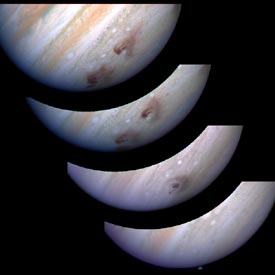
This mosaic shows the G impact site of Comet Shoemaker-Levy 9. From lower right to upper left it shows a view 5 minutes after impact, the same location 1.5 hours later, 3 days later (the L impact site is to G's right) and 5 days later.
Courtesy R. Evans, J. Trauger, H. Hammel, and the HST Comet Science Team and NASA.
This week marks the 10th anniversary of Comet Shoemaker-Levy 9 impacting the clouds of Jupiter. Here Sky & Telescope contributing editor and SL9 codiscoverer David Levy reflects on some of the events surrounding the Great Comet Crash.
As I write these words I'm on my way home after attending a star party along the shores of Lake Titicaca in Bolivia, where I witnessed a Milky Way so bright that it clearly cast a shadow. It's images like these that remind me how nature's wonders appear to be unending.
It was my desire to study these wonders that led me on my decades-long quest to hunt for comets. I began searching in earnest in 1965. Since then my strategy has remained the same: it's the search that's most important, not the number of comets I might find along the way. Thus, the evening of March 23, 1993, began as many other evenings did, with the sky full of clouds and a lot of hope.
That spring night I was at Palomar Observatory in California. Gene and Carolyn Shoemaker, my observing partners for nearly five years, were at my side as we waited for the sky to clear. With the clouds mostly gone the next field in our observing program happened to include Jupiter, and we began taking photographs. This was our search routine, as always, conducted in the cold of the dome. We had no computer nor heated control room. It was just us, the sky, and whatever target might be lurking out there.
We knew that our film contained overexposed images of Jupiter. What we didn't know was that they also recorded the strangest comet ever discovered. When we first saw it, Shoemaker-Levy 9 looked more like the bat-shaped B-2 Stealth Bomber than a comet, with several tails and two long "wings" of dust. Its grace and beauty masked the gentle majesty of its breakup when on July 8, 1992, tidal stresses ripped the comet's core apart as it flew just 21,000 kilometers (13,000 miles) above the Jovian cloud tops. The breathtaking image also masked the unbelievable violence that was to come.
Trapped by Jupiter's gravity, SL9 never again left the Jovian system. On July 16, 1994, the comet's first fragments careened headlong into the Jupiter's atmosphere at 60 kilometers per second, fast enough to cross the United States in about a minute. That afternoon the Shoemakers, planetary scientists, the media, and I were at the Space Telescope Science Institute in Baltimore, Maryland, awaiting the Hubble Space Telescope's first images of the impact. It was there that we first learned of the worldwide observational reports. Telescopes from Calar Alto in Spain to Antarctica had recorded a plume of material arching thousands of kilometers above Jupiter.
But for me, the highlight of SL9's impact week took place at the U.S. Naval Observatory in Washington D.C., on the evening of July 21st. There were hundreds of people waiting to catch a glimpse of Jupiter's battered face through a bevy of telescopes. As I peered into the eyepiece of the observatory's 26- and 12-inch refractors, I was overwhelmed by the series of big, dark spots lining Jupiter's southern hemisphere.
A decade later, as I watched the Milky Way brighten the southern hemisphere sky, it all became clear to me: surely in the light of all those stars, comets were hitting other worlds. After all, comet impacts are common in the vastness of space and time. But what a privilege to know that on this world, for one great week, we got to watch one.
 0
0
Comments
You must be logged in to post a comment.